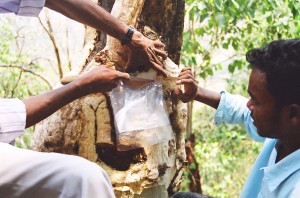Gum Karaya
This page deals with following facts about gum karaya:
Biological source and synonyms,geographical sources, collection, purification , storage, purity standards, description, chemical constituents and uses of gum karaya.
Biological source and synonyms
Gum karaya is a dried gummy exudate obtained from the tree Sterculia urens (Roxburgh), Sterculia villosa (Roxburgh), Sterculia tragacantha (Lindley) or other species of Sterculia (Sterculiaceae). It is also known as Indian tragacanth, Sterculia gum, Karaya gum, Thapsi Gum, Katiera, Gum Kadaya, Kullo, Katilo, Karei, Gulu, Katera, Kandol.
Geographical source
It is grown in abundance in the many parts of India especially in west and central India , in the tropical himalayas and across the eastern and western ghats covering the states of Bihar,Maharashtra, Orissa, Andhra Pradesh, Gujarat, Uttarakhand, Rajasthan,Karnataka,Jharkhand,some districts of Madhya Pradesh and Chhatisgarh.
Apart from India ,it is also found in Pakistan,Indonesia,Thailand, Vietnam,Sudan, Panama,Senegal,Phillipines and in Australia.
Collection
Suitable trees are selected for production of gum Karaya. The trees having a girth of at least 1 metre are selected, and a section of bark is stripped off to make blazes. Generally two blazes are made confined to the main stem situated 3 feet above from the ground.These blazes are tapped and immediately after tapping ,the exudation oozes out .Exudation is maximum during first 24 hours of blazing and continues upto two weeks or so.Although the gum exudes through blazes throughout the year ,during the hot weather the flow is more copious.Then it gets solidified in the form of gum tears.The large irregular tears which weigh in pounds are collected.
Blazing: Generally the number of blazes to be made per tree, should not be more than two. However the number of blazes that can be more if the girth of the stem is more than 1.5 meters. The depth of blaze should not be more than 1 to 1.5cms by the time the second layer gets exposed and rows of blazes should be alternate. Also the blazes made should be semicircular having a base of approximately 12cms wide. Blazing of the tree also affects the health of the tree as the excessive horizontal blazing ,much deeper blazing makes the tree prone to borer attack.Hence blazing should be done properly causing minimal harm to the tree.
Tapping: The best season for tapping is March-April upto June or till the commencement of the monsoon.During the rainy season the yield of gum is reduced as the produced gum cannot be easily dried and at times it gets completely washed-off owing to heavy rainfall during monsoon.The gum produced is of low quality because of high impurity and moisture content during monsoon. The plants are tapped again from September depending upon the climate and geographical area.Hence we can say that for tapping ideal season is October to June or all the year round except the monsoons,although better quality material is obtained during January to June.
Continuous Tapping should be avoided in order to give sufficient healing time to blazes and improve productive life of the tree. However if tapping is needed to be continued in second and third year then the first year blaze should be extended by 5cms. On an average the tree is tapped about five times during it’s life.
Purification of Gum Karaya
The process of purification of the Gum Karaya involves the following steps-
- The large irregular tears obtained from the collecting centers are broken into small pieces to expedites drying.
- These small pieces are dried to remove it’s moisture content and in order to bleach the colour to certain extent.
- The pieces of bark, sand particles, wood, dust and foreign organic matters are removed either through physical means or by using hot blowing air.
- The sand particles are removed by gravity.
- The size reduction and air flotation of loose bark ensures purification to certain extent.
- The granulated or crystal gum karaya has particle size between 6 nad 30 mesh.Fine powdered variety usually passes through 150 mesh screen.
- Based on colour,impurities and size grading of gum into various categories is done.
Yield
The yield per tree is about 1 kg to 5 kgs per year.However it is to be mentioned that, both the quality and the quantity of the gum yield depends upon many factors such as the geographical location ,climate,time of tapping for collection, number of blazes formed, size of the girth of the trunk ,how old is the tree etc. Red bark tree gives higher yield compared to it’s white bark counterpart. The gums yielded by the trees growing on hill-slopes are more in quantity and better in quality as compared to others.
Storage of Gum karaya
Preferably gum karaya should be stored in air tight containers under cold conditions.
Description
- Colour-It is found in the form of irregular tears or vermiform pieces of white to brown in colour.
- Odour-It has slight acetous odour.
- Taste-It has bland mucilaginous taste.
- Solubility-It is insoluble in water, but forms a translucent colloidal solution. Powdered gum swells in water.
- Wood-fibers and small sand particles can be present in the drug.
Purity Standards
The produced gum karaya should comply with following standards;-
- The content of foreign organic matter in the produced gum karaya should not exceed 3%.
- The acid insoluble ash of the produced gum karaya should not exceed 1%.
Chemical constituents
- Acetyl group compounds = 8%
- Uronic acid residues = around 37%
- On acid hydrolysis ,it gives D-galactose, D-galacturonic acid, L-rhamnose, aldobiuronic acid and an acid trisaccharide.
Gum karaya gives pink colour with solution of ruthenium red ( unlike tragacanth ).
Uses of Gum Karaya
- Gum karaya is used mainly because of it’s property to form a viscous or colloidal solution,gel, stable films, moisture and water absorbing properties,
- adhesiveness abilities and ability to resist microbes and hydrolysis by mild acids.
- It’s various uses are:-
- It is a good bulk laxative ,as it swells about 60 - 100 times in water and is neither digested nor absorbed by the body.
- As denture adhesive in dental treatment.
- As emulsifier,thickener and stabilizer in pharmaceuticals.
- Used on large scale in foods such as ice-pops,cheese spread,sherbats,ground meat products. Karaya gum is listed in the food chemical codex.
- As wet end additive in paper manufacture along with starch.
- For making of synthetic pulp for fruit juices as it has the property to swell in cold waters.
- Also used in cosmetics for making hair dressing lotions for hair setting preparation.
- Other uses-Also used in petroleum and natural gas producing industries, textile industry.
- It's role in production of Linoleum,Varnishes,Ice-creams,Jellies, Paper coating , Oil cloth,Inks, Polishes and engraving process is also documented.
References:
Non-timber forest products exchange program India.
Pharmacognocy by Dr. C.K.Kokate P.hd, Mr. A.P Purohit M.Pharm, S.B Gokhale M. Pharm




